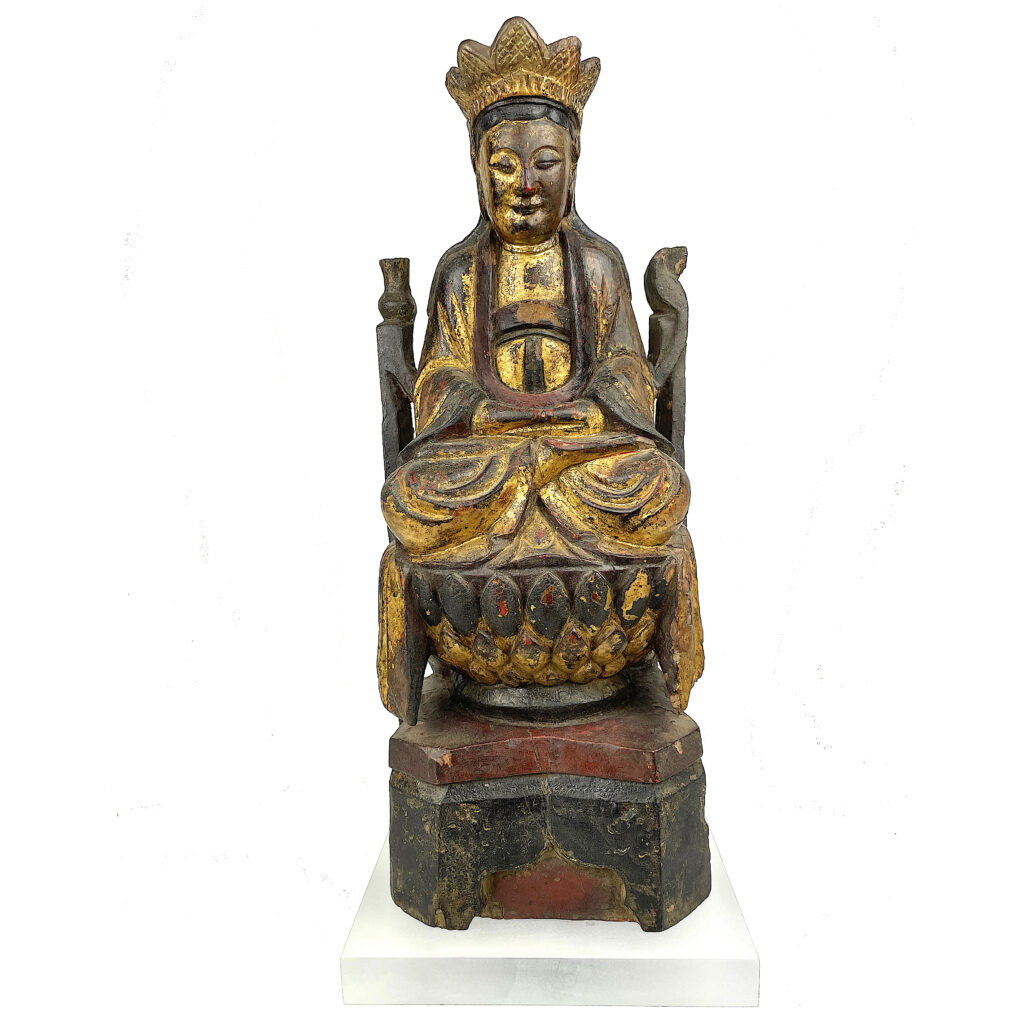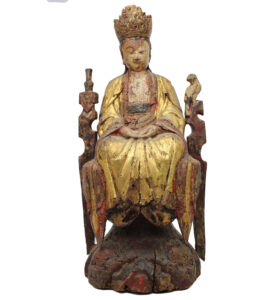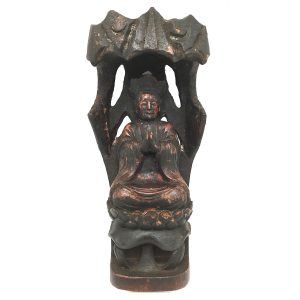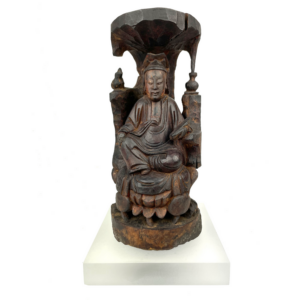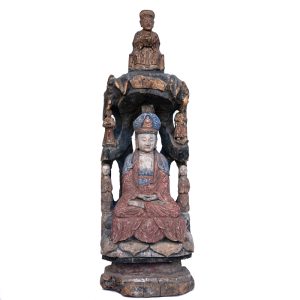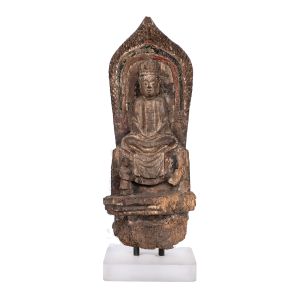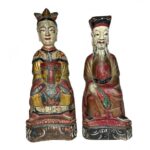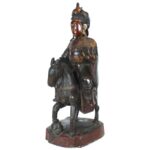The Emergence of Nanhai Guanyin, Guanyin of the South Sea
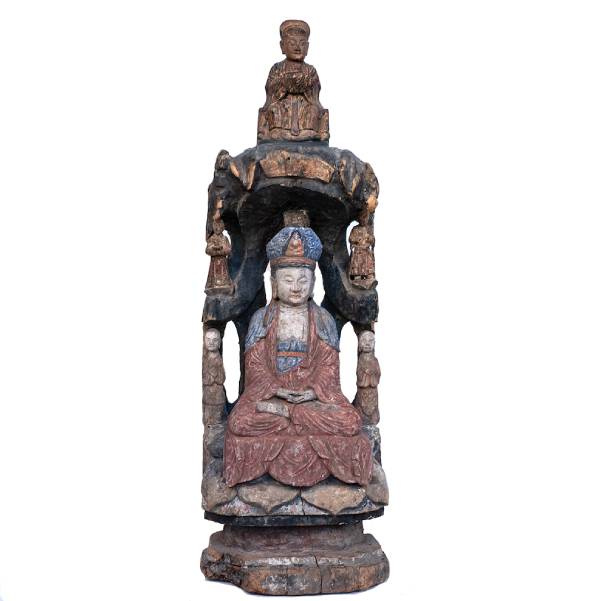
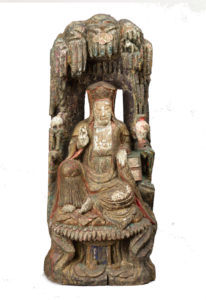
One of the more popular Chinese depictions of Guanyin, especially during the Ming and Qing Dynasties, is the seated Bodhisattva in her “Cave of the Tidal Sound” (Chaoyin Dong) on Mount Putuo (Putuoshan) on the island of Putuo, which means “beautiful white flower” in Sanskrit. It is a small island in the East China Sea renown for centuries for its beauty, spirituality and natural wonders that include grottoes, mystic caves, exotic rock formations, exquisite landscapes, tranquil valleys, golden beaches, and religious sites of temples and monasteries. Guanyin is believed to reside in the Cave of the Tidal Sound in front of the Purple Bamboo Forest very close to the sea where one continually hears the thundering sounds of the tide.
Putuoshan, Guanyin’s Sacred Mountain
Putuoshan is one of four Chinese Buddhist Mountains, each of which is presided over by a major Buddha or Bodhisattva. It is Guanyin’s sacred mountain and her Bodhimanda, a Pali word meaning “place of enlightenment” and referring to the spot that the Bodhisattva occupied before they became enlightened, taught the Dharma, or performed other significant functions. During the Sung Dynasty (960-1279), Putuo became the designated residence of Guanyin in Mahayana Buddhism, and from that time on rulers, officials, religious personages, and devotees from all over the Buddhist world made pilgrimages to the island where she is said to reveal herself to the faithful. By the Ming dynasty, Putuo had become the national and international center for Guanyin worship that resulted in a new authorized iconographical manifestation of Guanyin called Nanhai Guanyin or Guanyin of the South Sea. Putuoshan had been a spiritual Taoist location and a Taoist Sacred Mountain revered for more than 2000 years. By the first century B.C., it was famous as one of the special places where the Taoist “pill of immortality” was created.
Prior to its official designation as Guanyin’s residence, Guanyin was depicted as the Avalokitesvara, the often mustached male Indian Buddhist Bodhisattva from the Theravada Buddhist tradition. According to the Buddhist scripture called the Garland Sutra (Avataṃsaka-sūtra) written during the Tang dynasty in the 7th century, Avalokitesvara lived on the mythical spiritual island of Potalaka in the south sea of India as the Ruler of the Southern Seas where he looked down compassionately upon mankind. As Mahayana Buddhism later spread throughout China, Avalokitesvara was transformed to the female bodhisattva Guanyin, and acceptance by religious and government officials that Putuo was Potalaka in the South China Sea contributed to Guanyin’s rise as the most revered bodhisattva in the Chinese Buddhist pantheon. From the Song Dynasty on important officials, famous literati, and well-known writers, artists, and other celebrated personages visited the island and wrote profuse and ardent praises about Putuo.
The Origins of Nanhai Guanyin
Local scriptural references, miracle tales, folklore, testimonials of elite pilgrims, and mountain gazettes further legitimized Putuo as the home of Guanyin. These accelerated the rise in popularity of the Guanyin of the South Sea type that soon became a frequently depicted figure in Buddhist murals, paintings and sculpture. By the twelfth century she was increasingly described as “Our Lady in White” or the “White Clad Guanyin” (budhistdoor.com, part 3) and portrayed as a young beautiful radiant bodhisattva in a white robes with a hood covering her head most commonly standing in front of bamboo, encircled by a full moon, seated or standing on a lotus or throne, or riding astride a sea creature. These imperially sanctioned portrayals occupied official Guanyin temples and shrines.
Guanyin’s popularity, especially in her Nanhai manifestation, expanded greatly during the Ming and early Qing dynasties when her Chinese “heritage” became more apparent and well known, and she increasingly became embraced by Chinese Taoist and Popular Folk Religion adherents as well as all Buddhists. Many Chinese symbols associated with Nanhai Guanyin such as the moon, water, vase, and fish were introduced in her portrayals, and small wood and stone carvings proliferated in provincial areas where local artisans carved figurines placed on or in home altars and village, community, and clan shrines. While imperially sanctioned and created, Guanyin images wore lavishly adorned garments with implied jewels, beads, and scarves emphasizing the riches of enlightenment, images fashioned by local untrained but skilled artisans during the Ming and Qing periods were less formal, elaborate, and ornate and were more humble, relatable, and more heavily emphasized her compassionate traits. Symbolic white hooded robes, although usually covered with lacquer that darkened over time, and nominal jewels, if any, replaced the elegant robes, royal jewelry, and scarves. Indeed, the art produced outside urban areas by provincial craftsmen reflected the taste of the local people whose devotions were also influenced by Taoist and Popular Folk Religion and shamanic traditions and relied on local beliefs that strongly resonated with common people rather than strictly adhering to approved formal iconographic prescriptions.
In provincial Nanhai Guanyin carvings, the Bodhisattva often sits in a modified lalitsana pose, the “royal ease” or “relaxation posture, usually with one leg bent and the other either pendant and bent at the knee or up with the knee also bent and the foot flat on the surface. One arm usually rests behind with the hand on the flat surface to support her weight and the other arm may rest atop her raised knee, hold a sutra scroll, or rest on stacked books representing Buddhist sutras. She is normally seated on a symbolic craggy rock outcrop and often framed by an arch of openwork draped moss with pierced openings at the sides and back that represents her at the entrance to the Tidal Cave at Putuo. She may hold a lotus, scrolled sutra, or vial symbolizing the tears of her followers, also explained as the nectar or dew of compassion and immortality, and she is perched atop an open lotus or a throne held up by open and/or closed lotuses. The lotus is the Buddhist symbol of the flowering of the mind and freedom from the darkness of this world, and it normally appears in connection with enlightened beings. Its symbolism is simply and beautifully summarized: just as the lotus is rooted in the mud and blooms when reaching for the light, so through Buddhist teachings and practice can individuals rise and reach enlightenment, especially if helped along by a compassionate Bodhisattva. According to the Lalitavistara Sutra, “…the spirit of man can be transformed, like a lotus bud growing out of the mire towards the sun.” In Buddhism an open lotus symbolizes realized enlightenment, while a closed lotus bud symbolizes potential enlightenment.
Many unique symbols are associated with Nanhai Guanyin. Sometimes her arm rests on books or holds scrolls representing the dharma (teachings of the Buddha or Buddhist scriptures) that she recites in her cave to devotees. If there may be a stack of books, they symbolize sutras and especially the ones in which she is mentioned, including the Lotus Sutra where she is referenced as the “compassionate bodhisattva” and the Hua-yen Sutra that describes her as the Bodhisattva of Mount Potala and Putuo. (Reed p.161) A vase, often with a willow branch, is also interpreted as containing the holy precious dew of healing, a symbol of Guanyin’s compassion that she uses to bless all living beings with physical and spiritual. She is often seen with a rosary that enables her to call upon Buddha for succor, and the beads are said to embody nirvana (enlightenment) and representing all sentient beings which when turned symbolizes Guan Yin freeing them from of their state of misery and repeated rounds of rebirth into enlightenment . A white parrot or dove sometimes rests on a surface on her right or hovers behind her right side. The combination of the vase and the white parrot as has its origins in the Pure Land Sutra which describes the Pure Land as home to parrots and other rare birds who help those who have achieved rebirth in the Western Paradise. The saga of the white parrot is also related in the “Precious Volume of the Parrot” (Yingge Baojuan) which relates how the parrot escaped capture by hunters and, when he returned home to find his mother had died, he immediately fainted in grief. Moved by his filial piety, Guanyin revived the parrot by sprinkling him with the pure water from her vase using her willow branch. She also assisted the parrot’s parents to achieve a worthy rebirth. In gratitude, the parrot asked to accompany Guanyin for eternity. (Yu, p. 165). As sung in the Chinese opera “heavenly Maiden Sprinkles Flowers”:
Guanyin’s Chinese Acolytes: Shan Tsai (Sudhana) and Longnu, the Dragon Girl)
During the Ming Dynasty, Nanhai Guanyin was often portrayed as a triad with two attendants, the young boy Shan Tsai (called Sudhana in Sanskrit) with his hands in prayer on her right and the Dragon Princess Longnu(also Long Nue, Longnü) offering her the “illuminating pearl” on her left. According to the Avatamsaka Sutra, Shan Tsai was a young disabled pilgrim who visited 53 teachers to study the Buddhist Dharma. Despite his physical disabilities, he managed to visit Guanyin at Putuo who decided to test his resolve to learn Buddhist teachings. She created the illusion of pirates threatening her life, and when Shan Tsai saw her in danger he hobbled and chased them off a cliff. Guanyin then saved him in mid air, restored his ability to walk, transformed him into a handsome youth, and taught him the entire Buddhist Dharma.
Longnu’s story includes Shan Tsai and is equally compelling. (onenationonline) A fisherman caught the son of The Dragon King who ruled the South Sea while he was in the form of a fish. As he was land bound, his dragon father could not help him, so he pleaded with Heaven and Earth for help. Guanyin head his cries and sent Shan Tsai to help. The fish-son was about to be sold at market at a very high price, as many people in the crowd thought eating the fish would grant then immortality. As the crowd grew raucous, Guanyin called from afar “A life should definitely belong to one who tries to save it, not one who tries to take it.” The son-fish was immediately returned to the sea, changed back into a dragon, and swam home. In gratitude, the Dragon King had his daughter Longnu presented Guanyin the “Pearl of Light,” his jewel of unequalled worth that shone continuously and provided Guanyin light in the darkness to read the dharma. Longnu became Guanyin’s disciple, and other Buddhist scriptures indicate that in return Guanyin went to the Dragon King’s palace to reveal to him the dharani, a sacred Buddhist Sanskrit phrase used for protection and as a support for concentration. In gratitude, Dragon King’s daughter Longnu then presented Guanyin with his jewel of unparalleled worth. Shan Tsai and Longnu are usually depicted in the triad as young children with Shan Tsai holding his palms joined in reverence (anjali mudra) and knees bent to show he was once disabled, while Longnu holds a bowl, ball, or ingot symbolizing the precious “Pearl of Light.”
The Influence of Taoist and Popular Folk Religion
As belief in Nanhai Guanyin spread throughout China, she absorbed qualities associated with other female deities, including local Taoist and Popular Folk Religion deities such as sea goddesses or mountain spirits. Especially during the Ming Dynasty, she is shown standing atop swirling waters on a sea monster or giant fish, with a leaping fish emerging from the ocean, or a sea creature or dragon. As the protector of fishermen, her role is to literally rescue those in danger at sea and protect mankind by taming the wilder aspects of the seas and rivers. Sandy Boucher (p. 43) writes that Nanhai Guanyin was probably derived from beliefs in local sea goddesses throughout Southern China for centuries before the onset of Buddhism. In all these presentations, the waves symbolize samsara, the cycle of birth, death, and rebirth.
Other factors during the Ming Dynasty contributed to Nanhai Guanyin’s popularity. In his celebrated novel “Journey to the West” (Xiyou ji), author Wu Chengen described his pilgrimage to Putuo, and in the “Complete Biography of Guanyin of the South Sea” (Nanhai Guanyin Quanzhuan) the Jade Emperor, the supreme deity of Taoism and of Chinese Popular Folk Religion, appointed “the Efficacious Guanyin of Great Loving Kindness and Compassion who Saves People from Suffering and Hardship … to be the mistress of the Putuo Rock of the South Sea in perpetuity.” (Yu, p. 164). Ming Emperor Wanli revitalized Putuo as a major pilgrimage site, which continued under Qing Dynasty emperors Kangxi and Yongzheng. Temples in her honor sprang up throughout China, and smaller figurines were frequently placed on home and community altars and shrines. Because many were destroyed during the Cultural Revolution and those that were saved were stored in secret for long periods of time where they were unattended, deteriorated, and became infected, surviving pieces were damaged over time, became increasingly rare, and are now highly collectable and popular. Most show signs of degradation due to natural causes; some have old repairs and may have relatively new repairs.
The follow pieces that appear in this Blog are not yet on line: 16404, 16263. Inquiries about them are welcome.
Guanyin with Vial, Parrot, Shan Tsai and Longnu in Cave (16404)
Massive Ming Guanyin in Cave Massive Ming Guanyin in Cave (16243)
Published Sources
Bagyalkakshmi, “The Creation of Goddess of Mercy from Avalokitesvara” in Across the Himalayan Gap, New Delhi, Gyan Publishing House, 1998.
John Blofeld, Bodhisattva of Compassion: The Mystical Tradition of Kuan Yin, Denver, Shambala Publications, 1978.
Sandy Boucher, Discovering Kwan Yin: Buddhist Goddess of Compassion, Boston, Beacon Press, 1999.
Jose Ignacio Cabezon, “Mother Wisdom, Father Love: Gender-based Imagery in Mahayana Buddhist Thought,” in Buddhism, Sexuality, and Gender, Albany, State University of New York Press, 1992.
Chun-Fang Yu, Kuan-yin: The Chinese Transformation of Avalokitesvara, New York, Columbia University Press, 2001.
Chun-Fang Yu, “Kuan-yin: The Chinese Transformation of Avalokitesvara” in Marsha Weidner, Ed. Latter Days of the Law: Images of Chinese Buddhism 850-1850, Honolulu, University of Hawaii Press, 1994.
Patricia Eichenbaum Karetzky, Images of Asia: Chinese Buddhist Art, New York, Oxford University Press, 2002.
Patricia Eichenbaum Karetzky, Guanyin, New York, Oxford University Press, 2004.
Eloise Hart, “Kuan Yin: Goddess of Mercy, Friend of Mankind,” Sunrise Magazine, December, 1984.
Susan Naquin and Ch’un-fang Yu, “Pilgrims and Sacred Sites in China,” Studies on China, No. 150, Berkeley, University of California Press, 1992.
Martin Palmer and Jay Ransay with Man-Ho Kwok, Kuan Yin: Myths and Prophecies of the Chinese Goddess of Compassion, London, Thorsons, 1995.
Barbara Reed, “The Gender Symbolism of Kuan-yin Bodhisattva,” Buddhism, Sexuality and Gender, , Albany, State University of New York Press, 1992.
Web Sources
Buddhistdoor, “The Four Mountain Sanctuaries, Buddhism and the Four Mountains, Part 1”,
Buddhistdoor, “The Four Mountain Sanctuaries, Mount Putuo, Part 3”,

